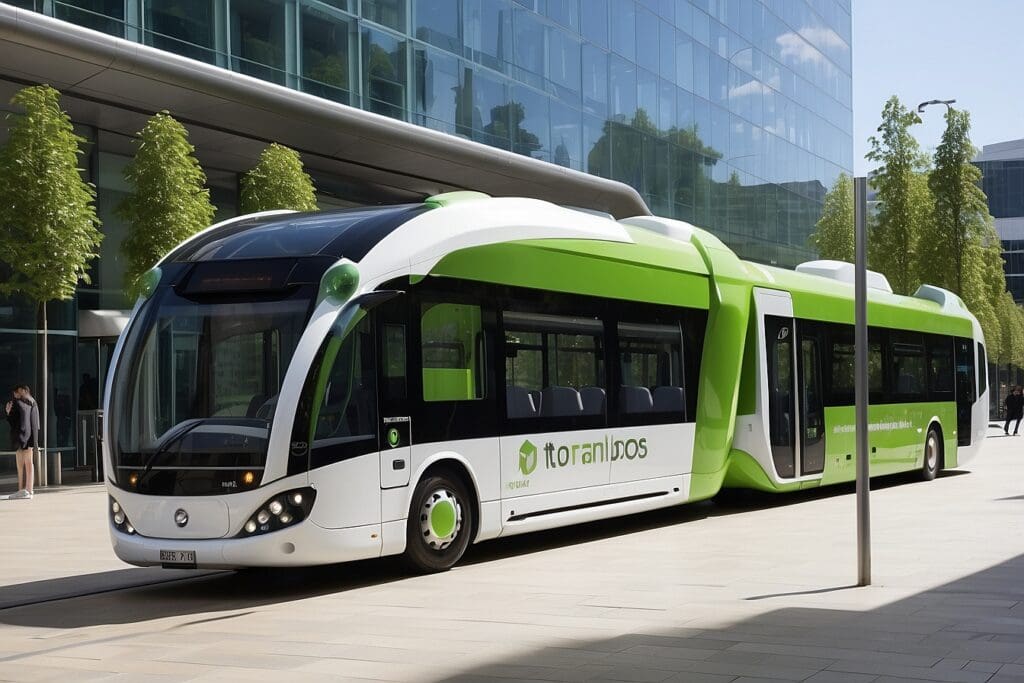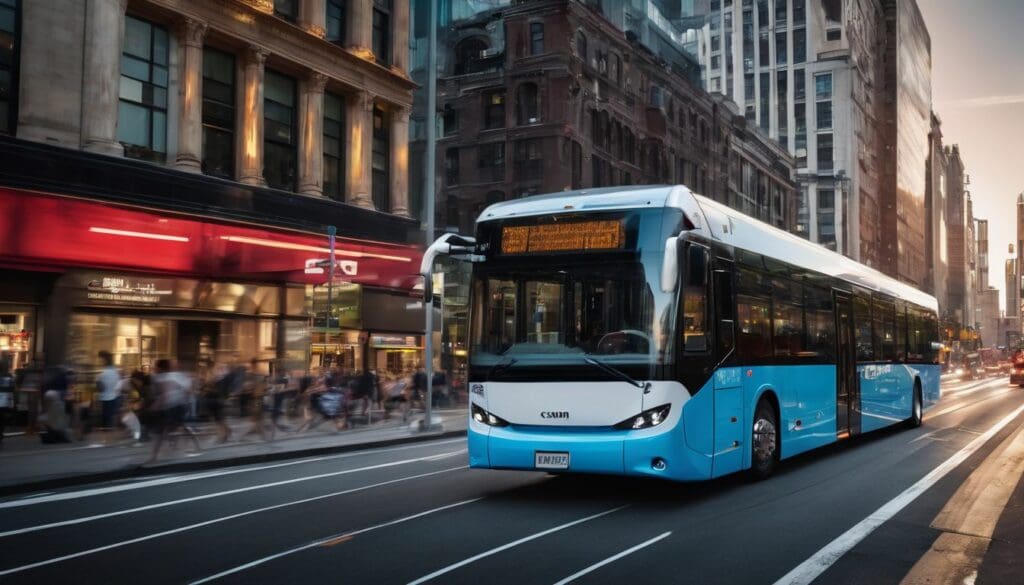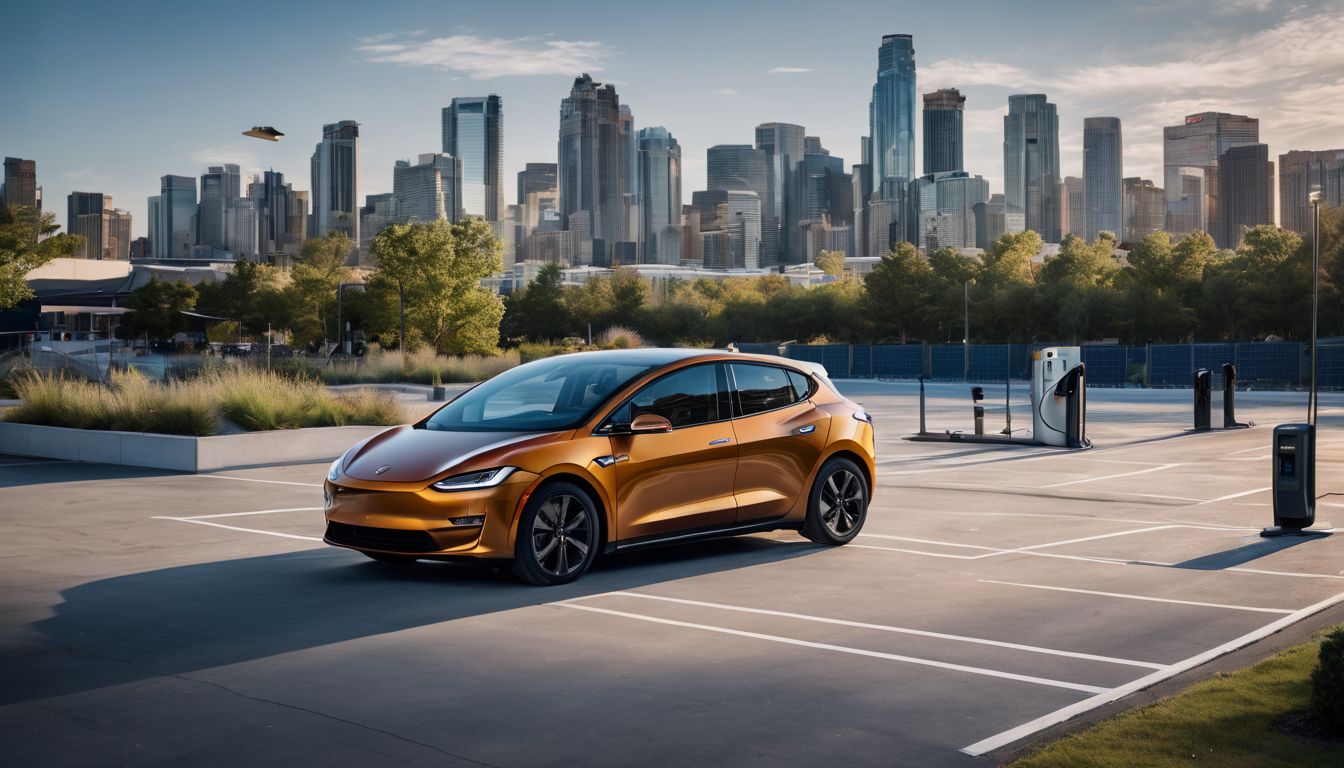We all understand the tussle of navigating our local streets whilst endeavouring to tread lightly on the Earth. Just like you, we’ve been on the lookout for more environmentally sound modes of transport and it seems public transportation is nearing a watershed moment in sustainability.
In this piece, let’s delve into how cutting-edge electric buses and trains are leading us down a path to a cleaner tomorrow. A standout statistic has caught our attention: by harnessing electric vehicles, we could slash global carbon emissions by an impressive 1.5 gigatonnes annually come 2030.
Isn’t it quite stirring? Let’s embark together on this encouraging shift towards eco-friendly travel!
Key Takeaways
- Electric buses and trains are revolutionising public transport by providing zero – emission travel options, helping reduce global carbon emissions significantly.
- Advanced features such as regenerative braking systems, quiet operation, and energy-efficient designs make these vehicles not only eco-friendly but also cost-effective and comfortable for daily commuters.
- The adoption of electrified trams in cities is promoting sustainable urban development with their efficient operation, reduction in noise pollution, and ability to carry a high number of passengers.
- Governments worldwide are facilitating this green transition through incentives and subsidies to encourage the use of electric public transportation over traditional fossil fuel-powered vehicles.
- Future public transport will likely integrate technology for flexible services across different city landscapes, using apps for reliable planning while transforming urban spaces to cater better to pedestrian needs and environmental sustainability.
The Rise of Electric Public Transportation

Electric buses are quickly becoming a popular choice for public transport due to their eco-friendly and sustainable features. With zero emissions, electric buses are making a positive impact on urban environments while providing efficient and reliable services for commuters.
Advantages of Electric Buses
Electric buses are changing the game in public transport, offering a cleaner and more sustainable way to travel. We’re seeing cities across the globe embrace these eco-friendly vehicles, and here’s why:
- Reduced emissions: Electric buses produce zero tailpipe emissions, which means they help keep the air cleaner by not pumping pollutants like nitrogen oxides and particulates into our atmosphere.
- Lower noise pollution: These buses operate quietly, reducing the noise pollution that can be so common in busy urban areas. Quieter rides make for a more pleasant journey for passengers and less disturbance for residents.
- Cost-effective operation: With fewer moving parts compared to traditional diesel engines, electric buses tend to have lower maintenance costs. They also benefit from being more energy-efficient, leading to savings on fuel costs over time.
- Energy independence: By using renewable energy sources such as solar or wind power for charging, electric buses can help reduce dependence on fossil fuels and contribute towards energy self-sufficiency.
- Incentives and subsidies: Governments worldwide offer various incentives to encourage the adoption of green public transportation. These can include tax rebates and grants to support the initial investment in eco-friendly technologies.
- Flexibility in design: Without the need for large engines or fuel tanks, electric buses have more flexible design options. This allows manufacturers to create spacious interiors with better accessibility features.
- Positive image: For riders who care about their carbon footprint, choosing electric buses feels good. It boosts public perception of mass transit as a responsible choice for eco-conscious commuting.
- Support local innovation: Investing in electric bus technology helps drive advancements in clean mobility solutions within local industries.
Features of Electric Buses
Electric buses are equipped with advanced features that make them a promising alternative to traditional diesel buses. They offer numerous benefits and advantages, such as:
- Reduced Emissions: Electric buses produce zero tailpipe emissions, helping to minimise air pollution and improve urban air quality.
- Quiet Operation: Electric buses operate quietly, contributing to reduced noise pollution in urban areas.
- Energy-efficient Design: They are designed with regenerative braking systems and energy storage capabilities, optimising energy usage and reducing overall environmental impact.
- Enhanced Safety Features: Electric buses come with advanced safety features such as collision avoidance systems and emergency braking technology, ensuring the safety of passengers and pedestrians.
- Innovative Technology Integration: These buses often incorporate cutting-edge technology for real-time monitoring, route optimisation, and passenger amenities to enhance the overall commuting experience.
- Sustainable Materials: Many electric buses are built using sustainable materials and eco-friendly manufacturing processes to support environmental conservation efforts further.
Impact on Public Transportation
Electric buses are transforming public transport with their eco-friendly and sustainable features. As a result, the carbon emissions from traditional bus fleets are being significantly reduced, contributing to cleaner air in urban areas.
The integration of electric buses into public transport systems enhances efficiency and reliability, offering commuters a more environmentally conscious option for their daily travels.
The global shift towards electrified public transport is creating opportunities for greener and more sustainable cities. This transformation in the transit industry not only supports environmental conservation but also provides a practical solution for reducing the overall carbon footprint of urban commuting.
Electrified Trams: Revolutionizing Urban Commuting
Electric trams are reshaping urban commuting with their eco-friendly and efficient transportation solutions. With benefits such as reduced emissions and improved air quality, electrified trams are proving to be a sustainable alternative for city travel.
Benefits of Electric Trams
Electric trams offer numerous benefits for environmentally conscious individuals, supporting conservation and environmental sustainability. Here are the advantages:
- Reduced Carbon Emissions: Electric trams produce zero tailpipe emissions, contributing to cleaner urban air and a healthier environment.
- Energy Efficiency: Electric trams are highly efficient, utilising regenerative braking systems to recover and reuse energy, thus reducing overall power consumption.
- Noise Reduction: These trams operate quietly compared to traditional diesel-powered vehicles, minimising noise pollution in urban areas.
- Sustainable Urban Development: Electric trams support sustainable city planning by promoting public transportation and reducing reliance on private vehicles.
- Enhanced Passenger Comfort: They provide a smoother and quieter ride, improving the overall commuting experience for passengers.
Statistics on Electrified Trams
We must turn our attention to the compelling numbers surrounding electrified trams, as these figures paint a promising picture for the future of sustainable urban transit. Here’s an overview encapsulated in an HTML table:
| Statistic | Detail |
|---|---|
| Global Fleet Size | Over 55,000 electrified trams |
| Energy Efficiency Improvement | Up to 24% more efficient than traditional trams |
| Emission Reduction | Can reduce greenhouse gases by 50,000 tonnes per year |
| Passenger Capacity | Carries up to 250 passengers, equivalent to 3 buses |
| Operation Cost Reduction | Reduces operational costs by about 20% compared to diesel trams |
| Life Cycle | 30+ years with proper maintenance |
| Adoption Rate | Europe leads with a 92% electrification rate of tram systems |
| Noise Pollution Reduction | 30% lesser noise than conventional trams |
These statistics underscore our commitment to advancing urban mobility solutions that respect the planet while meeting the needs of city-dwellers. We’re steadfast in advocating and adopting measures that align with conservation and environmental values, ensuring that public transport remains at the heart of sustainable city living.
Paving the Way for Sustainable Cities
With the advantages of electrified public transportation, cities can benefit from reduced carbon emissions and improved air quality. The efficiency and reliability of eco-friendly buses and trains also contribute to sustainable urban development.
Advantages of Electrified Public Transportation

Electrified public transportation offers numerous advantages, making it a sustainable and efficient choice for environmentally conscious individuals.
- Reduces carbon footprint by operating on renewable energy sources, lowering global GHG emissions.
- Enhances air quality with zero-emission vehicles, contributing to eco-friendly commuting.
- Promotes energy efficiency, utilising renewable energy in transportation and decarbonising the industry.
- Lowers noise pollution in urban areas, providing a quieter and more pleasant travel experience for commuters.
- Improves public health by reducing harmful emissions that can lead to respiratory issues and other health concerns.
- Reduces dependency on fossil fuels, promoting the use of environmentally friendly vehicles for sustainable urban mobility.
- Boosts public transit innovation by paving the way for future public transportation ideas and technology advancements.
Impact on Carbon Emissions and Air Quality
Switching to eco-friendly public transportation, such as electric buses and electrified trams, significantly reduces carbon emissions and improves air quality. By using zero-emission vehicles, we can play a crucial role in decarbonising transport and creating more sustainable cities.
This shift leads to cleaner urban environments and healthier living conditions for all, contributing to the global effort to combat climate change.
The adoption of green public transportation has already shown promising results in lowering harmful emissions. As we embrace eco-conscious commuting options like low-emission trains and hyperloop technology, we actively contribute to reducing our environmental footprint.
Efficiency and Reliability
Electrified public transportation systems offer remarkable efficiency and reliability. By utilising modern technologies, these transport networks ensure punctual services and minimal downtime, enhancing the overall passenger experience.
Zero-emission vehicles are designed for optimal performance, providing a dependable and sustainable mode of travel. Moreover, these eco-friendly buses and trains are equipped with advanced features to guarantee smooth operations, contributing to the creation of greener urban environments.
The electrification of public transport signifies a significant step towards sustainable mobility solutions. With low-emission trains and zero-emission vehicles at the forefront of decarbonising transport, commuters can rely on efficient services that prioritise environmental conservation.
Design and Features
The design and features of eco-friendly buses and trains are tailored to maximise energy efficiency and reduce environmental impact. Electric buses typically feature regenerative braking systems and lightweight materials to improve fuel economy, while low-emission trains incorporate eco-conscious technologies such as hydrogen fuel cells or battery-electric powertrains.
Additionally, these vehicles often integrate modern amenities like LED lighting, efficient air conditioning, and ergonomic seating for a comfortable commute.
Furthermore, the use of sustainable materials in the construction of public transportation vehicles not only minimises their carbon footprint but also supports the development of a circular economy.
The Future of Public Transport: Embracing Technology and Sustainability
Public transport in the future will be a blend of technology and sustainability, with flexible services for both small and large cities, mobility hubs for accessibility, app integration for planning and reliability, and a transformation in the concept of urban spaces.
These advancements will revolutionise the way we commute and contribute to a more eco-friendly mode of transportation.
Flexible Services for Small and Large Cities
- Introducing hybrid buses that can efficiently navigate narrow city streets and accommodate varying passenger capacities.
- Implementing on-demand transit services that adjust routes based on real-time data, enhancing accessibility for residents in smaller communities.
- Developing integrated ticketing systems that allow seamless travel across multiple modes of transport within a city or region.
- Expanding microtransit options, such as electric shuttles and ride-sharing initiatives, to provide flexible first- and last-mile solutions for urban areas with dispersed populations.
- Creating dedicated lanes for electric buses and trams in congested urban centres, prioritising public transit over private vehicles without impeding traffic flow.
- Integrating smart technology into bus stops and tram stations, offering real-time arrival information, accessibility features, and environmentally friendly infrastructure.
Mobility Hubs for Accessibility
Mobility hubs provide convenient access to different modes of transportation. They offer seamless connections between buses, trains, trams, and other forms of sustainable transport. At these hubs, commuters can easily transition from one mode of transportation to another without any hassle. This promotes the use of public transport and reduces reliance on individual vehicles.
- Mobility hubs integrate various transport modes
- They enhance connectivity and accessibility for commuters
- Provide amenities such as bike storage and charging stations
- Enable efficient transfer between different modes of eco – friendly transportation
App Integration for Planning and Reliability
- Real – time data from apps allows passengers to plan their journeys more efficiently, reducing waiting times and minimising environmental impact.
- Integration of ticketing systems onto apps streamlines the overall experience, making it easier for individuals to access public transport.
- Mobile apps provide live updates on schedules, delays, and alternative routes, ensuring a reliable and convenient travel experience.
- GPS tracking enables users to locate nearby stops, contributing to increased usage of eco-friendly buses and trains.
Changing the Concept of Urban Spaces.
Urban spaces are adapting to accommodate the growing trend of eco-friendly public transportation. The integration of sustainable transport has led to a shift in urban planning, with an emphasis on creating pedestrian-friendly areas and reducing reliance on private cars.
This change is promoting greener, healthier, and more vibrant city centers while encouraging a sense of community and interconnectedness.
The adoption of electric buses, trams, and trains has sparked a renaissance in urban design that prioritises accessibility over car-centric infrastructure. These changes are laying the groundwork for dynamic, sustainable cities that thrive on environmentally conscious commuting.
Conclusion
In conclusion, eco-friendly buses and trains are reshaping public transportation. They offer sustainable, efficient, and reliable commuting options. Embracing technology and sustainability is pivotal in revolutionizing urban mobility.
The future of public transport lies in eco-conscious solutions that prioritize environmental conservation while meeting the needs of a growing population. Together we can build greener cities with zero-emission vehicles at the heart of our transit systems.
FAQs
1. What is the future of public transport technology?
The future of public transport technology focuses on introducing eco-friendly buses and trains that help decarbonise transport by lowering emissions.
2. Why are low-emission trains important for the future?
Low-emission trains are crucial as they contribute to an eco-conscious commuting system, helping reduce pollution and protect our environment.
3. Are there plans for zero-emission vehicles in public transit?
Yes, the push towards a sustainable future includes developing zero-emission buses and trains as a key part of modernising our public transport systems.
4. How will eco-friendly buses change daily travel?
Eco-friendly buses promise cleaner air and quieter streets, making daily travel more pleasant whilst significantly cutting down carbon footprints from commutes.





